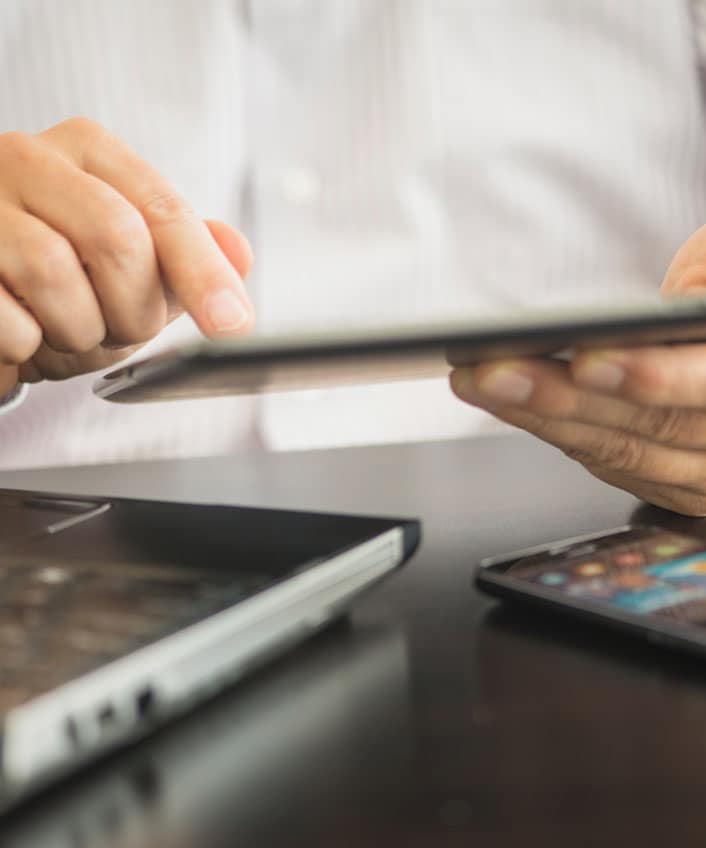The risks of public Wi-Fi
Did you know there could be threats lurking in the background on public Wi-Fi while you balance your bank account and sip a latte at your favorite cafe?

Picture this. It’s Saturday morning and you’re hanging out at your local coffee shop using the free Wi-Fi to catch up on a few tasks you couldn’t quite get to during your busy week. Sound familiar? This is a typical scenario for many of us, but did you know you might be unaware of some threats lurking in the background on public Wi-Fi while you balance your bank account and sip a latte?

Help protect your digital life on your devices.
Are you afraid of losing your personal information or all the precious things on your computer? Get comprehensive protection with Norton Security Deluxe across all your devices – up to 5 PCs, Macs, smartphones or tablets.
Create an account today and try it free for 30 days on up to 5 of your devices.
What is public Wi-Fi?
Public Wi-Fi can be found in popular public places like airports, coffee shops, malls, restaurants, and hotels — and it allows you to access the Internet for free. These “hotspots” are so widespread and common that people frequently connect to them without thinking twice. Although it sounds harmless to log on and check your social media account or browse some news articles, reading e-mail, checking your bank account, or performing any activity that requires a login is risky business on public Wi-Fi.
What are the risks?
The problem with public Wi-Fi is that there are a tremendous number of risks that go along with these networks. While business owners may believe they’re providing a valuable service to their customers, chances are the security on these networks is lax or nonexistent.
Man in the Middle attacks
One of the most common threats on these networks is called a Man in the Middle (MitM) attack. Essentially, a MitM attack is a form of eavesdropping. When a computer makes a connection to the Internet, data is sent from point A (computer) to point B (service/website), and vulnerabilities can allow an attacker to get in between these transmissions and “read” them. So what you thought was private no longer is.
Unencrypted networks
Encryption means that the messages that are sent between your computer and the wireless router are in the form of a “secret code,” so that they cannot be read by anyone who doesn’t have the key to decipher the code. Most routers are shipped from the factory with encryption turned off by default, and it must be turned on when the network is set up. If an IT professional sets up the network, then chances are good that encryption has been enabled. However, there is no surefire way to tell if this has happened.
Malware distribution
Thanks to software vulnerabilities, there are also ways that attackers can slip malware onto your computer without you even knowing. A software vulnerability is a security hole or weakness found in an operating system or software program. Hackers can exploit this weakness by writing code to target a specific vulnerability, and then inject the malware onto your device.
Snooping and sniffing
Wi-Fi snooping and sniffing is what it sounds like. Cybercriminals can buy special software kits and even devices to help assist them with eavesdropping on Wi-Fi signals. This technique can allow the attackers to access everything that you are doing online — from viewing whole webpages you have visited (including any information you may have filled out while visiting that webpage) to being able to capture your login credentials, and even being able to hijack your accounts.
Malicious hotspots
These “rogue access points” trick victims into connecting to what they think is a legitimate network because the name sounds reputable. Say you’re staying at the Goodnyght Inn and want to connect to the hotel’s Wi-Fi. You may think you’re selecting the correct one when you click on “GoodNyte Inn,” but you haven’t. Instead, you’ve just connected to a rogue hotspot set up by cybercriminals who can now view your sensitive information.
How to stay safe on public Wi-Fi
The best way to know your information is safe while using public Wi-Fi is to use a virtual private network (VPN), like Norton VPN, when surfing on your PC, Mac, smartphone or tablet. However, if you must use public Wi-Fi, follow these tips to protect your information.
Don’t:
- Allow your Wi-Fi to auto-connect to networks
- Log into any account via an app that contains sensitive information. Go to the website instead and verify they are using HTTPS before logging in
- Leave your Wi-Fi or Bluetooth on if you are not using them
- Access websites that hold your sensitive information, such as such as financial or healthcare accounts
- Log onto a network that isn’t password protected
Do:
- Disable file sharing
- Only visit sites using HTTPS
- Log out of accounts when done using them
- Use a VPN, like Norton VPN, to make sure your public Wi-Fi connections are made private

Help protect your digital life on your devices.
Are you afraid of losing your personal information or all the precious things on your computer? Get comprehensive protection with Norton Security Deluxe across all your devices – up to 5 PCs, Macs, smartphones or tablets.
Create an account today and try it free for 30 days on up to 5 of your devices.
Editorial note: Our articles provide educational information for you. Our offerings may not cover or protect against every type of crime, fraud, or threat we write about. Our goal is to increase awareness about Cyber Safety. Please review complete Terms during enrollment or setup. Remember that no one can prevent all identity theft or cybercrime, and that LifeLock does not monitor all transactions at all businesses. The Norton and LifeLock brands are part of Gen Digital Inc.





Want more?
Follow us for all the latest news, tips and updates.